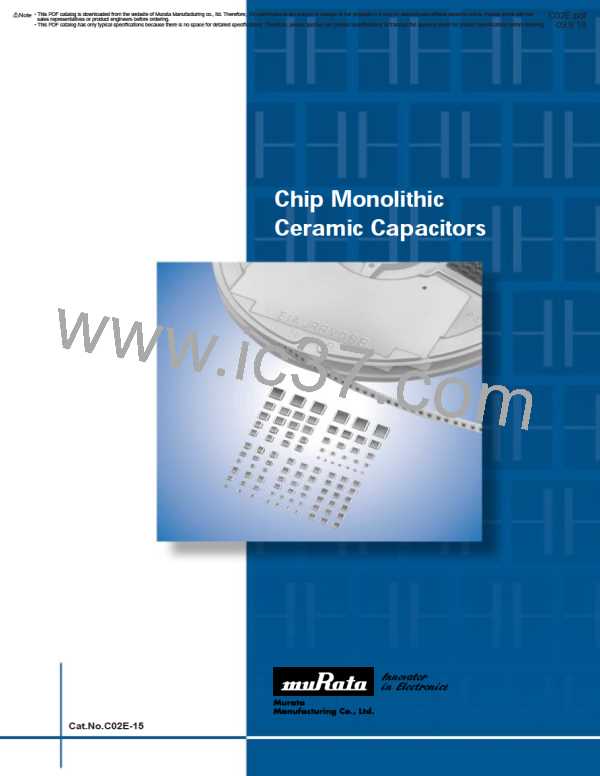• This PDF catalog is downloaded from the website of Murata Manufacturing co., ltd. Therefore, it’s specifications are subject to change or our products in it may be discontinued without advance notice. Please check with our
• Please read rating and !CAUTION (for storage, operating, rating, soldering, mounting and handling) in this catalog to prevent smoking and/or burning, etc.
!Note
!Note
C02E.pdf
sales representatives or product engineers before ordering.
• This catalog has only typical specifications because there is no space for detailed specifications. Therefore, please approve our product specifications or transact the approval sheet for product specifications before ordering0. 9.9.18
• This PDF catalog has only typical specifications because there is no space for detailed specifications. Therefore, please approve our product specifications or transact the approval sheet for product specifications before ordering.
!Caution
Continued from the preceding page.
5. Flow Soldering
When sudden heat is given to the components, the
mechanical strength of the components should go down
because remarkable temperature change causes
deformity of components inside. And an excessively long
soldering time or high soldering temperature results in
leaching by the outer electrodes, causing poor adhesion
or a reduction in capacitance value due to loss of contact
between electrodes and end termination.
[Standard Conditions for Flow Soldering]
Temperature (D)
Soldering
Peak Temperature
Gradual
Cooling
∆T
170°C
150°C
130°C
Preheating
In order to prevent mechanical damage in the
components, preheating should be required for both of
the components and the PCB board. Preheating
conditions are shown in Table 2. It is required to keep
temperature differential between the soldering and the
components surface (∆T) as small as possible.
When components are immersed in solvent after
mounting, be sure to maintain the temperature difference
between the component and solvent within the range
shown in Table 2.
Time
5 seconds max.
60-120 seconds
[Allowable Soldering Temperature and Time]
270
260
250
240
230
Do not apply flow soldering to chips not listed in Table 2.
Table 2
0
10
20
30
Soldering Time (sec.)
Part Number
Temperature Differential
∆TV150D
G--18/21/31
In case of repeated soldering, the accumulated
soldering time must be within the range shown above.
Recommended Conditions
Pb-Sn Solder
Lead Free Solder
250-260°C
N2
Peak Temperature
Atmosphere
240-250°C
Air
Pb-Sn Solder: Sn-37Pb
Lead Free Solder: Sn-3.0Ag-0.5Cu
Optimum Solder Amount for Flow Soldering
The top of the solder fillet should be lower than the
thickness of components. If the solder amount is
excessively big, the risk of cracking is higher during
board bending or under any other stressful conditions.
Up to Chip Thickness
Adhesive
in section
Continued on the following page.
18
212

 MURATA [ muRata ]
MURATA [ muRata ]